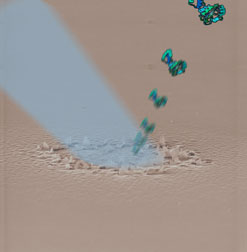A new technique developed by US researchers could pave the way for faster analysis of biological samples by first vaporising them using laser light.
Nanostructure-Initiator Mass Spectrometry (NIMS) can detect small biological molecules directly from a sample of tissue or blood - allowing low levels of drug metabolites, for example, to be detected in single cells without the time-consuming sample preparation needed in other techniques.
NIMS uses a specially-prepared surface consisting of a porous nanostructure impregnated with 'initiator' molecules. Test samples are placed onto the surface, then the initiator molecules are triggered by irradiation. This causes the initiators to violently erupt - vaporising the test sample.

Illustration superimposed on a scanning-electron microscope image of the NIMS surface after irradiation with a single laser shot (blue), revealing localized surface destruction.
© Nature
|
Trent Northen and Gary Siuzdak, of the Scripps Research Institute in La Jolla, California, helped develop the new technique. 'Basically, we pull the rug out from under the sample so that it finds itself in the gas phase, ready for detection,' they said.
A variety of different initiator molecules and irradiation techniques can be used, but the team got good results using perfluorinated siloxane initiators in combination with laser light.
'We have placed videos on our website showing how to make these surfaces,' said Siuzdak. 'We hope that other researchers will be encouraged to try different initiators or nanostructure surfaces to further improve the technology.'
Oscar Yanes, who also worked on the project, notes that NIMS complements existing techniques, such as electrospray ionization (ESI) and matrix-assisted laser desorption/ionization (MALDI). 'We analysed a variety of molecules to compare the three different ionization methods and observed that they overlap yet each one reveals unique molecules; NIMS can detect molecules that you would never see with the others and vice versa.'
Steven Boxer, a professor of chemistry at Stanford University, California, who uses mass spectrometry to analyse biological molecules, told Chemistry World: 'This field is still developing and research like this is great. Mass spectrometry allows you to get really detailed information that you can't get from other methods, so improvements could be very helpful for many applications.'
Lewis Brindley




